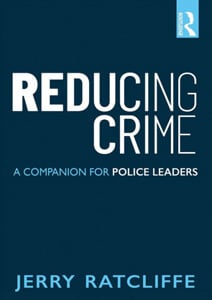Book Review: Reducing Crime, A Companion for Police Leaders
Reducing Crime: A Companion for Police Leaders. By Jerry Ratcliffe. Routledge; routledge.com; 242 pages; $30.95.
Drawing on his extensive experience as a police officer in England and researcher and consultant to police departments around the world, author Jerry Ratcliffe examines crime-reduction strategies from the perspective of a police department in Reducing Crime: A Companion for Police Leaders. An accompanying website contains additional materials and updated links. The website is easy to navigate and a valuable addition to the book.
While the author looks at crime from a policing perspective, there is some crossover to security operations. Most security entities do not have the broad responsibilities across a diverse landscape that police departments do. Different reporting requirements and limited or no arrest powers are factors impacting security needs. However, a well-thought-out defensible strategic plan to address crime and the protection of assets is something every organization needs.
Because security operations do not take place in a vacuum, learning how the local police agency approaches crime problems can be useful. Understanding the many factors influencing crime in surrounding areas is critical to developing a strategic security plan that reduces potential consequences of crime and improves safety by reducing hot spots, implementing proactive measures, and reducing opportunities.
Reducing Crime introduces memory aids throughout to help the implementation of a crime reduction program. For example, the PANDA (problem, analyze, nominate, deploy, assess) crime reduction model calls for identifying and analyzing the problem before intervention. Once the strategy is identified and selected, it is implemented and assessed to identify any problems and adjust strategies to meet desired goals.
The author discusses crime analysis, why individuals commit crime, evidence-based policing, crime management, police leadership, and the importance of understanding crime patterns. The text includes current figures and tables as well as vignettes from experienced police professionals. The core goals of the strategic police leader are to prevent crime, increase community safety and security, and build public trust and confidence—excellent goals for any security organization.
Reviewer: John Boal, CPP, PCI, CFE (Certified Fraud Examiner), served as a military advisor in Vietnam and had a 25-year career in a municipal police department. He taught criminal justice and security courses at the University of Akron.
